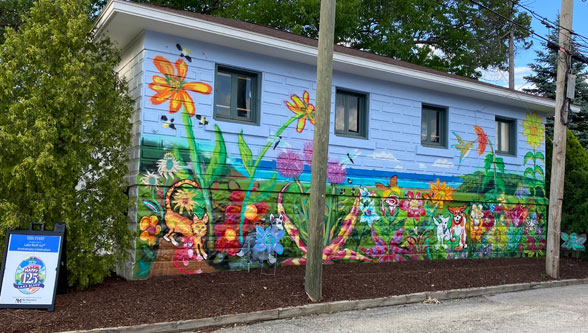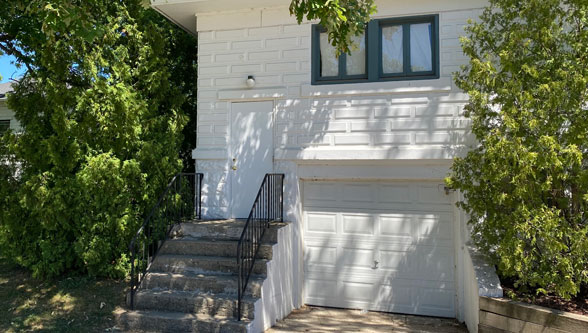A small, plain building that a lot of people in town refer to as “the Walnut house” recently got an exterior refresh, courtesy of the Lake Bluff 125 Committee. Designed by artist Sandie Bacon and painted by cadre of volunteers, the south-facing wall mural represents the flora and fauna of Lake Bluff and is one element of a three-part public art display celebrating the Village’s 125+1 anniversary.
But just what is that knobby-concrete building across the street from Hansa Coffee that looks like it’s been there forever? The structure at 611 Walnut Avenue has a long, interesting history that reflects the Village’s own narrative arc. It was built circa 1887 as a coach house to the American foursquare around the corner at 33 E. North Avenue, which remains today a private home. The split-level coach house is built of sturdy stuff: pressed brick on the upper level and rusticated concrete blocks below.
Rusticated concrete blocks started being used in American homes in the 1860s, with the first patent being granted in 1866. The blocks were created in a mold from raw materials such as cement, sand and aggregates that were readily available at a time of decreasing lumber supply. The blocks gave the appearance of rough natural stone but were less expensive and lighter in weight. They had another benefit that may have been on the builder’s mind: fire resistance.
In Lake Bluff’s late 18th century summer resort days many of the houses, cottages and hotels were wood frame, gas-lit and highly flammable; in fact many burned to the ground just two or three decades after they were built. Meanwhile 33 North and 611 Walnut are today among the Village’s longest standing structures.
The coach house was a residence inhabited by different people over the decades, but in 1928 it was a science laboratory.
The Sanborn Fire Insurance map of 1928 lists the occupant of 611 Walnut Avenue as Fansteel Products Co. Radio Laboratory; it also indicates the structure had hot-water heating and electric lights. Fansteel was founded in North Chicago in 1907 by Carl Pfanstiehl, a Highland Park resident who received 135 patents in electricity, chemistry, and metallurgy, and his work led to advances in the automobile industry, radio technology, and military equipment during both World Wars.
The North Avenue house has a connection to the Lake Bluff Children’s Home. According to Museum archives, it is believed that at some point John Griffith gave 33 E. North Avenue to the Children’s Home to accommodate an overflow of children, but it apparently was not used for that purpose. It is also believed that a woman named Miss Clements, who worked at the Children’s Home, lived at 33 North.
From approximately 1954 to ’63, the coach house was both a business and a residence, according to local telephone books. The business was Lake Bluff Cab Co. run by John D. Rohner, who drove the taxi and lived at 611 Walnut with his wife and family. The Rohners are notable because their daughter was Margaret Rohner Lindman, a locally famous puppeteer to a generation of Chicago-area children. Mrs. Lindman was a Lake Bluff teacher in the 1950s who had a side gig running a puppeteering company called Lindman Marionettes with her husband and sister, staging puppet shows at Ravinia’s Murray Theater and the Miracle of Books Fair at the Museum of Science and Industry. From 1962 to ‘64, Mrs. Lindman hit it big with her own weekly TV show called “Just Imagine” on WTTW’s Channel 11.
Lake Bluff History Museum has a number of Lindman marionettes in its archives, thanks to a 2019 donation from Northeastern Illinois University. An exhibit featuring some of the Lindman puppets is planned for 2022.
Fast forward to the 21st Century. In 2005, 611 Walnut was run down and gutted. At that time the Village was seeking to build up the downtown, so it purchased the property for $325,000 with an eye on land-banking it for future redevelopment. This was when Block 1 was being planned, a development that would go on to rev the Central Business District from lights-out to lights are definitely on at Lake Bluff’s many restaurants, pubs and cafés, as well the Block Parties, Criterion Bike Race, Lake Bluff History Museum Auto Show, and other events.
These days the coach house is more like a storage locker. Lake Bluff non-profit organizations store supplies for programs and events on the upper level, while Public Works uses the ground floor as a maintenance shed/garage for the Central Business District.
And the south-side exterior wall of this humble structure? Lake Bluff 125 Committee volunteers have turned it into a public mural representing the beauty of our community and the vibrancy and fun atmosphere characteristic of Lake Bluff.

